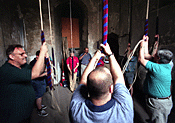June 14, 1999 |
| Citizen
Voices '99 What your neighbors are saying. |
 |
After 123 years, ringing how they were meant to be rung.
Church bells take on an old peal
 |
| The bells at St. Mark's Church are rung by members of the North American Guild of Change Ringers. In change ringing, the bells turn in complete circles, instead of chiming back and forth. (Michael Mally / Inquirer Staff Photographer) |
INQUIRER STAFF WRITER
And now, at St. Mark's Church, the bells commemorate themselves, and the resumption of a Sabbath tradition that had been dormant for more than a century.
For the first time in 123 years, the church on the 1600 block of Locust Street tolled its bells the way they were meant to be rung -- a process known as a change ringing. Instead of chiming back and forth, the bells were put through the full range of motion, turning in complete circles before returning to their original position.
The bells, cast by the same British firm that cast the Liberty Bell, were put back into service after experts spent nearly a year replacing a worn frame and bell mounts with steel fittings. They also moved the bells into larger quarters inside the tower.
The difference -- changing, as opposed to chiming -- was like a chorus compared to one voice, a summer storm's rumbling approach instead of a single thunderclap.
"It's beautiful," said the Rev. Richard Alton, beaming skyward as the first notes burst into the sky moments after he concluded 11 a.m. Mass yesterday at the church, near Rittenhouse Square. "The bells were meant to be played like that."
But the bells were not always so popular.
In 1876, the church installed four bells to commemorate the nation's centennial and first rang them for Sunday services that June -- at 6:30 a.m. Blasted from their beds, neighbors quickly complained to the city. In early 1877, the Court of Common Pleas issued an injunction against any more of St. Mark's early-morning calls to worship.
In 1878, the church added four more bells, then moved all eight higher in the tower, hoping that elevating them would lessen their sound.
But the church made a fundamental error, said Peter Trotman, a bell specialist from Melbourne, England, who helped design and install the new framework, beginning in October.
"They moved them up too high," he said. "The bells did not have enough room to perform as they should."
The tapered tower was too narrow, the frame insufficient. The bells could only swing back and forth -- chiming, not changing. And so chime they did, joining the chorus of other downtown bells that pealed on holidays and other momentous events.
Yet some parishioners knew the bells were capable of more. Audrey Evans, a church member who measured her early years in York, England, by the peals of changing bells, in the early 1980s began urging St. Mark's officials to restore the bells to their original purpose.
"But there was never enough money," said Evans, 74, who immigrated here 30 years ago. "There was always something else to do."
The church in the late 1980s commissioned a study of the bells, which concluded that their fittings and wooden frame were insufficient and could damage the bells. They needed to be replaced with steel. Then, in 1996, a wheel that turned one of the bells shattered. Two years later, two other bells' fittings became so aged that they could not be rung, leaving only five bells operable. The church began raising money to restore its legacy in the tower.
In October, the church silenced all the bells, giving specialists time to design new fittings and move the bells lower in the tower where they would have more room to toll. British experts designed new attachments and shipped them to Philadelphia. For the last four weeks, they toiled in the tower, reassembling the structure, in a project that cost about $100,000.
The work came together yesterday morning as rotating teams of eight, trained to ring changing bells, began pulling on ropes dangling from a ceiling in the tower. Gears turned. Wheels spun.
Eighty feet below, passersby paused. Parishioners applauded.
And the bells of St. Mark's made a joyous noise, again.
©1999 Philadelphia Newspapers Inc.
